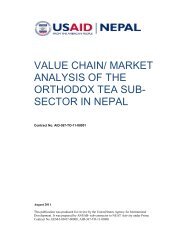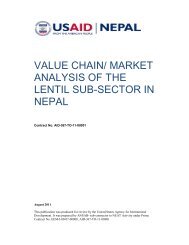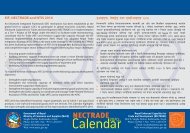value chain/ market analysis of the ginger sub-sector ... - Nepal Trade
value chain/ market analysis of the ginger sub-sector ... - Nepal Trade
value chain/ market analysis of the ginger sub-sector ... - Nepal Trade
- No tags were found...
You also want an ePaper? Increase the reach of your titles
YUMPU automatically turns print PDFs into web optimized ePapers that Google loves.
Conduct study tour <strong>of</strong> <strong>the</strong> farmers: Farmers <strong>of</strong> Assam, Bangalore and Cochin <strong>of</strong> India andChina are well equipped with improved knowledge <strong>of</strong> <strong>ginger</strong> cultivation. As a result, <strong>the</strong>farmers from <strong>the</strong>se areas to produce better quality <strong>ginger</strong>. Therefore, <strong>the</strong>re is a need toarrange a study tour <strong>of</strong> leader farmers to <strong>the</strong> production pockets <strong>of</strong> India and China.Develop linkage with MFIs: Farmers need external finance, primarily during seedprocurement. Therefore, it is recommended to develop linkages between micro-financeinstitutions <strong>of</strong> <strong>the</strong> project pockets and production groups.6.1.2 ProcessingSupport to establish rhizome washing facilities: Since <strong>Nepal</strong>i <strong>ginger</strong> is not washed before<strong>market</strong>ing, it looks dirty and is less competitive in <strong>the</strong> <strong>market</strong>s. Constructing a simplewashing facility, such as <strong>the</strong> one in Naxalbari India, can increase <strong>the</strong> competitiveness <strong>of</strong> <strong>the</strong><strong>Nepal</strong>i <strong>ginger</strong>. The washing facilities can be built in Butwal and <strong>Nepal</strong>gunj regions. InButwal region, a lead trader, Mr. Ram P. Pokharel, and <strong>the</strong> <strong>ginger</strong> processing cooperative <strong>of</strong>Palpa are interested in forming a partnership for building a <strong>ginger</strong> washing facility. In<strong>Nepal</strong>gunj region, Duduwakhla is one <strong>of</strong> <strong>the</strong> potential sites on which to build <strong>ginger</strong> washingfacility, since this is <strong>the</strong> central point <strong>of</strong> far-west and mid-west regions <strong>of</strong> <strong>Nepal</strong> for <strong>ginger</strong>.For local partnership, JABAN is interested in forming a partnership with NEAT Activity.This facility will not only add <strong>value</strong> to <strong>the</strong> product but also create employment at local <strong>the</strong>level, especially for women and disadvantaged groups.Introduce improved technology on Sutho making: During this study, <strong>the</strong> price <strong>of</strong> Cochin,a type <strong>of</strong> Sutho in Lucknow, was IRs 260/kg, while <strong>the</strong> cost <strong>of</strong> <strong>Nepal</strong>i Sutho was from IRs136 to 190/kg depending upon <strong>the</strong> quality. The Cochin type is attractive in appearance, withsome skins, while <strong>the</strong> <strong>Nepal</strong>i type is without skin and blackish in colour. If <strong>the</strong> technology <strong>of</strong><strong>the</strong> Cochin area is introduced in <strong>Nepal</strong>, farmers will get significantly higher prices.Introduce efficient slicing and drying technology: During our study, members <strong>of</strong> <strong>the</strong><strong>ginger</strong> cooperative <strong>of</strong> Palpa and members <strong>of</strong> an export company, Male International,expressed that <strong>the</strong> present cost <strong>of</strong> processing is very high due to inefficient slicing and dryingtechnology. Ginger cooperative <strong>of</strong> Palpa also has <strong>the</strong> similar experience on slicing anddrying. Male International mentioned that <strong>the</strong> <strong>Nepal</strong>i sliced <strong>ginger</strong> is not competitive ininternational <strong>market</strong>s due to <strong>the</strong> high cost <strong>of</strong> processing, despite its fair demand. At present,peeling and slicing <strong>of</strong> <strong>ginger</strong> is done manually. The solar dryer is rarely used and <strong>the</strong> dryersare not designed for commercial purpose. This has resulted in increased processing cost.Exporters are looking for <strong>the</strong> mechanical technology <strong>of</strong> slicing and drying in large scale,which reduces <strong>the</strong> unit cost <strong>of</strong> production. Therefore, it is recommended to NEAT Activity toprovide <strong>ginger</strong> slicing and drying technology to <strong>the</strong> entrepreneurs who are mostly involved inprocessing and export.Support diversification <strong>of</strong> products: Product diversification can be targeted both fornational and international <strong>market</strong>s. Since departmental stores <strong>of</strong> Kathmandu are importing<strong>ginger</strong> products, it is necessary to transfer <strong>the</strong> <strong>value</strong> addition technology at local level andlink <strong>the</strong>m to departmental stores, groceries, and retailers. Himalayan Naturals, a Kathmandubasedcommunity-private partnership company, has recently introduced <strong>ginger</strong> candy in <strong>the</strong>Kathmandu <strong>market</strong>, and <strong>the</strong> demand <strong>of</strong> <strong>the</strong> candy is not fulfilled. If <strong>the</strong> company is interestedin partnering with NEAT in order to gain efficient candy making technology.Value Chain/Market Analysis-Ginger 35






